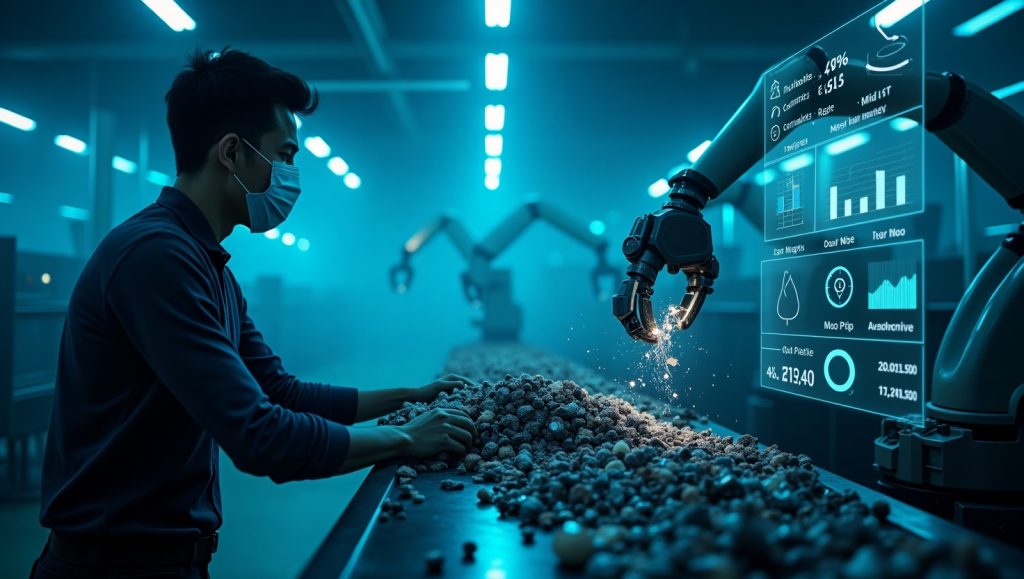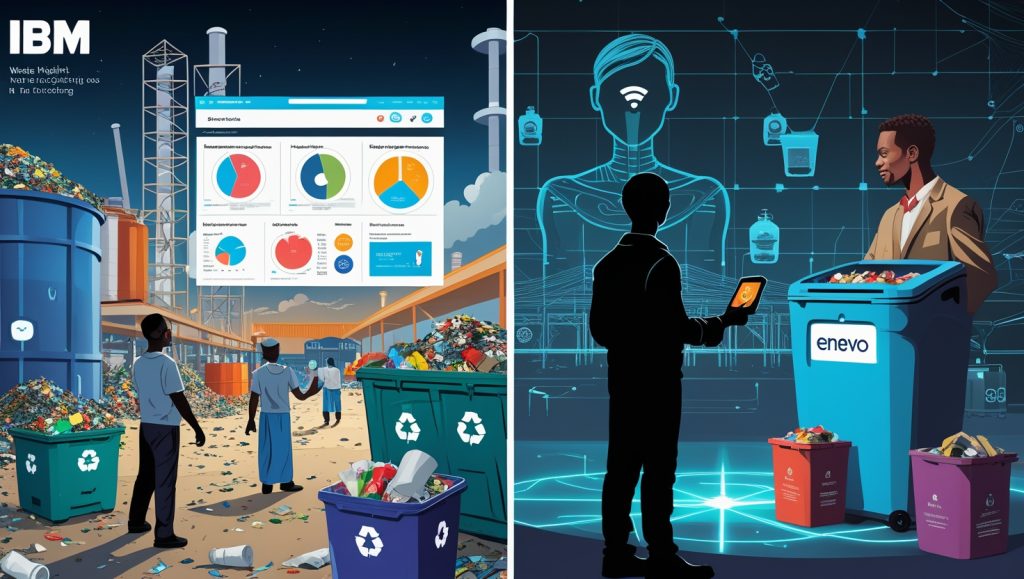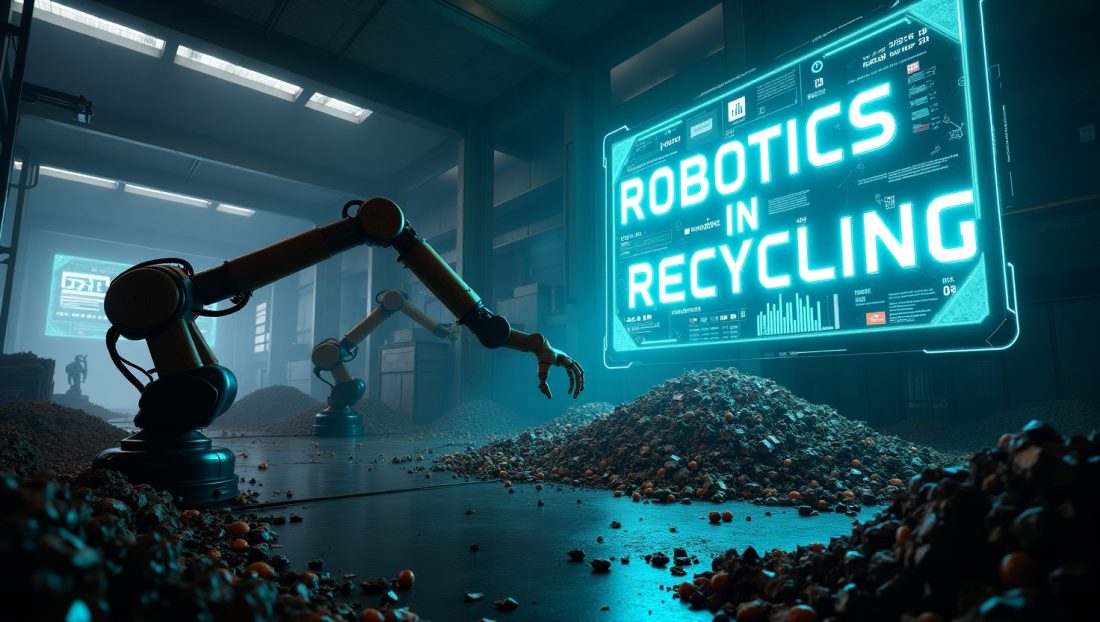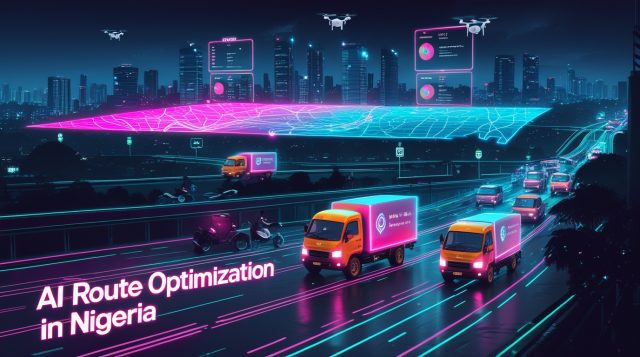The Tipping Point of Trash
In 2025, a landfill in Jakarta, Indonesia, collapsed under the weight of 2.1 million tons of unprocessed waste, burying a nearby village and poisoning its water supply. This tragedy, which displaced 3,000 people, underscored a grim reality: humanity generates 2.3 billion tons of municipal waste annually—enough to bury Manhattan 100 meters deep (World Economic Forum, 2025). Traditional recycling, reliant on underpaid workers sorting hazardous materials, is collapsing. Enter robotics in recycling—a fusion of AI, computer vision, and mechanical engineering that’s not just optimizing waste management but redefining humanity’s relationship with consumption. By 2030, this $42.7 billion industry will divert 450 million tons of waste from landfills annually. Here’s why this revolution is unstoppable—and what it means for our planet.
1. Why Manual Robotics in Recycling is a Broken System—And Always Will Be

Manual recycling is a relic of the 20th century, built on three fatal flaws:
The Human Cost
In 2024, a UK recycling facility reported 47% of workers suffered respiratory illnesses from inhaling microplastics, while 18% contracted infections from discarded needles. The job’s dangers explain why turnover rates exceed 70% in the U.S.—no one wants to sort trash for $13/hour while risking their health.
Inefficiency at Scale
Humans sort recyclables at 200–400 items per hour with 80% accuracy. Contamination rates in single-stream systems (where all materials are tossed together) hover at 25%, rendering entire batches unusable. For context, China rejected 1.3 million tons of U.S. recyclables in 2023 due to contamination, forcing cities like Philadelphia to incinerate waste.
The Black Plastic Problem
Traditional Near Infrared (NIR) sensors can’t detect black plastics, which absorb light. As a result, 95% of black food packaging—common in ready-meal trays—ends up in landfills.
The Robotic Solution
Enter AMP Robotics’ Neuron™ AI, which processes 1,200 picks per minute with 99% accuracy. Using hyperspectral imaging, it identifies black plastics by chemical composition, not color. In 2025, Denver’s Alpine Waste & Recycling facility deployed Neuron to recover 12 tons of black plastic monthly—enough to produce 480,000 new food containers.
2. Why Robotics in Recycling Is Economically Inevitable
Landfilling costs U.S. cities 55/tononaverage,whilerecyclingcosts55/tononaverage,whilerecyclingcosts150/ton. Robotics bridges this gap by unlocking hidden value in trash:
Rare Earth Metals: The E-Waste Goldmine
A single ton of smartphones contains 100x more gold than a ton of gold ore. Yet, less than 20% of e-waste is recycled. Apple’s Daisy robot, introduced in 2025, disassembles 1.2 million iPhones annually, recovering 1.1 tons of gold and 7.5 tons of aluminum—a $40 million annual yield.
Plastic’s Second Life
Clean, sorted HDPE plastic sells for 650/ton,butcontaminatedbatchesfetchjust650/ton,butcontaminatedbatchesfetchjust200. Recycleye’s AI-powered systems, deployed in 30 EU facilities, increased plastic purity to 98%, boosting profits by 220%.
SIMS Municipal Recycling, Brooklyn
In 2024, SIMS integrated ZenRobotics’ Heavy Picker system to sort construction waste. The robots recover 95% of metals and 80% of concrete, generating 4.2millionannuallyfromresale.“Before Robotics in recycling, we lost 4.2 million annually from resale.“Before Robotics in recycling, we lost 120,000 a month,” said CEO Tom Outerbridge. “Now we’re profitable.”
3. Why AI Vision Is Outperforming Human Eyes
Human sorters miss 1 in 5 items due to fatigue and visual limitations. Robotics in recycling leverages machine learning to see the invisible:
Hyperspectral Imaging
NC State’s Hawkeye System uses hyperspectral cameras to detect chemical fingerprints. In 2025, it identified 13 types of plastic in a mixed waste stream, including PVC (#3) and polystyrene (#6), which humans often confuse.
Real-Time Learning
AMP Cortex™ robots train on 50 million waste images annually. When a new candy wrapper design flooded markets in 2024, Cortex updated its algorithm in 72 hours to recognize the material—a task that would take humans months.
The Pizza Box Paradox
Grease-stained pizza boxes are unrecyclable via traditional methods. In 2025, Greyparrot’s AI partnered with Domino’s to tag contaminated boxes with UV markers. Robots at UK facilities now divert 19,000 tons of these boxes annually to biofuel plants instead of landfills.
4. Why Global Adoption Is Uneven—And Who’s Winning

While Western nations debate ethics, emerging economies are leapfrogging into the robotic era:
China’s State-Backed Dominance
Under the 2025 Robotics Blueprint, China installed 100,000 waste-sorting robots in Shanghai alone. These $15,000 units process 12 tons/hour, recovering rare metals for export. By 2026, China will control 60% of the global e-waste Robotics in recycling market.
India’s Informal Sector Revolution
Mumbai’s Dharavi slum, home to 13,000 informal waste pickers, adopted CleanRobotics’ TrashBot in 2025. The $5,000 AI bins sort waste at source, increasing pickers’ earnings by 40% while reducing exposure to toxins.
Contrast: U.S. Lag
Only 32% of U.S. waste is recycled, but startups like Glacier Robotics are targeting small towns. Their $300,000 modular robots increased recycling rates in Boise, Idaho, from 28% to 51% within a year.
5. Why Critics Fear a Job Apocalypse—And Why They’re Wrong
Detractors warn robotics in recycling will eliminate 200,000 jobs globally by 2030. The reality is more nuanced:
The Reskilling Revolution
Apple’s Robotics in Recycling Microfactories employ 1,200 former waste pickers as robot operators, paying $25/hour (+30% wages). Workers like Maria González, a single mother from Houston, attest: “I went from sorting trash to programming robots. My kids see me as a tech worker now.” This aligns with insights from your analysis of Why Robots Solve the Labor Crisis, which highlights how automation creates higher-skilled roles despite short-term disruptions.
New Roles, New Opportunities
The World Economic Forum forecasts 3.7 million new jobs in robot maintenance, AI training, and circular design by 2030. In Germany, Dual Vocational Programs now certify “Green Robotics Technicians,” blending mechanics with sustainability—a trend mirrored in Why Small Businesses Can’t Ignore AI to Survive, where small-scale recyclers adopt modular AI systems.
Ethical Dilemma: The Philippines’ E-Waste Children
In 2024, Manila shut down 23 informal e-waste sites employing 5,000 children. NGOs like Pure Earth replaced these with Robotics in recycling facilities, offering teens stipends to learn coding instead of burning circuit boards. This mirrors the ethical crossroads explored in Why AI Ethics Could Save or Sink Us, where unchecked automation risks exploiting vulnerable populations.
6. Why the Next Frontier Is Space-Grade Recycling
Lessons from space missions are reshaping terrestrial waste management:
NASA’s Closed-Loop Systems
On the ISS, 98% of water is recycled. In 2025, NASA partnered with Recycle.ai to adapt this tech for slums, where 2.2 billion lack clean water. Pilot projects in Nairobi now recycle sewage into drinkable water using solar-powered robots.
From Mars to Main Street
Perseverance Rover’s AI, designed to sort Martian soil, inspired WasteAID’s robotic composters. Deployed in famine-struck Somalia, they convert food waste into fertilizer, boosting crop yields by 50%.
7. Why Ethics Will Make or Break the Revolution

Without guardrails, robotics in recycling risks exacerbating inequality:
The Data Divide
AI relies on global waste data, but 60% of African nations lack digitized recycling records. In 2025, IBM’s Waste Insights began offering free AI models to Ghana and Kenya, trained on local waste patterns—a strategy akin to Why China’s Robot Cops Patrol, where tech is weaponized for both control and progress.
Who Owns Robotics in Recycling Data?
Robotics in recycling can offer Smart bins like Enevo’s ONe track consumer behavior. When Kroger sold this data to advertisers in 2024, privacy advocates sued. The EU’s AI Ethics Act (2026) now mandates anonymization, echoing warnings from Why the Dark Side of AI Threatens Our Future about data exploitation.
From Landfills to Lifelines
Robotics in recycling isn’t just about waste—it’s a mirror reflecting our capacity for reinvention. As waste picker-turned-engineer Luis Ramirez told The Guardian: “Robots didn’t steal our jobs; they gave us a ladder out of the dump.” By 2030, this $1.3T revolution will prove that trash, handled wisely, is the most abundant resource on Earth.

